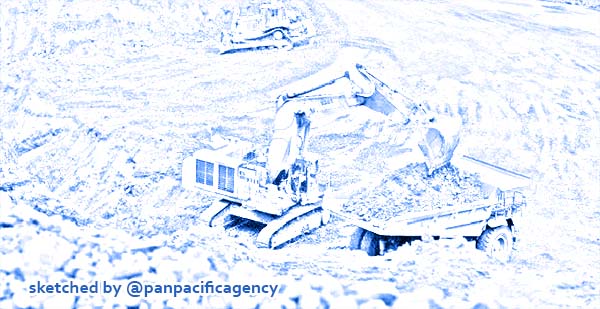[Analytics] Mining sector holds key to India’s recovery in post-Covid world

Activities at a nickel mining site. (Kontan/Cheppy A. Muchlis). Sketched by the Pan Pacific Agency.
India is poised to use the disruption caused by COVID-19 to lead into a phase of rapid industrialisation. The mining sector, like few other sectors, is the key to recovery in the post- pandemic world. Ishaan Jain specially for the Financial Express.
Traditionally, 1 per cent growth in mining results in an increase of 1.2-1.4 per cent in the growth rate of industrial production.1 direct job creates 10 indirect jobs. As per the 12th Five Year Plan of the Planning Commission of India, for every 1% increase in economic growth, the mining sector creates 13 times more employment than agriculture and six times more than manufacturing.
In other words, the sector’s contribution to the exchequer is well established. However, to achieve this potential, the mining industry needs serious interventions that can upend the superfluous jurisdictional framework and arrest the decline in the resource exploration and extraction industry.
The Ministry of Mines, with a view to attract domestic and foreign investments and achieve the goal of large-scale prospecting and optimal mining, adopted the National Mineral Policy, 2008, which was subsequently revised in 2019 (“NMP”). Under the NMP, the Ministry sought to promote large scale investments with the latest technologies in prospecting and mining by developing various structures to attract risk investments into survey and prospecting of mines and minerals, along with transparency in allocation of concessions to make it more conducive to investment and technology transfers/ flows. The NMP aimed for substantial investments by relaxing Foreign Direct Investment (FDI) norms and developing a long-term strategy for export of minerals, with an aim to establish mining as a modern standalone industry. The NMP also recommended incentivizing exploration to attract private investments as well as state-of-the- art technology, within the ambit of auction regime, through Right of First Refusal at the time of auction or seamless transition from Reconnaissance permit to Prospecting License to Mining Leases or auctioning of composite Reconnaissance Permit cum Prospecting License cum Mining Lease in virgin areas on revenue sharing basis or any other appropriate incentive as per international practice.
In a welcome move, the government recently allowed commercial mining in coal sector and FDI up to 100 per cent, with some exceptions, which is expected to spur investments in the mining sector. However, it is important to take cognizance that opening up FDI singularly does not result in large volumes of investments. Regulatory bottlenecks and cumbersome clearance mechanisms have to be addressed to enhance the ‘Ease of Doing Business’ quotient and improve the investment environment. Taking a step in this direction, the Ministry of Mines, vide its Order No. 16/42020-M.VI dated June 3, 2020 (“MOM Order”) suggested improvements in the grant of mineral concessions and better coordination between government agencies. The MOM Order sets out the guidelines for auction of mineral blocks with pre-embedded clearances and requires the setting up of a Project Monitoring Unit (“PMU”) by the State Governments.
The PMU shall be the applicant for the clearances required. The cost of the process shall be recovered from the successful bidder. Also, the PMU shall obtain the land rights as required for the mining project, in either case of the land being owned by either the state or central governments or private parties. The auction of mineral blocks with pre-embedded clearances is required to be taken up by the State Governments on pilot basis and this arrangement has the ability to address the industry issue of delay in grant of clearances and availability of land for mining, if adopted as a model for all auctions for grant of mining concessions. However, this will be only in-principle clearance. The actual clearance will have to be applied for by the concessionaire.
Another step in the same direction has been taken by Ministry of Coal, which is mulling over creating a Single Window Clearance Mechanism for quicker online application processing for approvals, including Environmental Clearance. The Ministry plans to onboard state government departments as part of the mechanism. The move aims to enhance Ease of Doing Business in India by allowing coal mines allocatees to secure approvals in a timely manner for Hon’ble Prime Minister Narendra Modi on 18 June
2020 unveiled the auction process of 41 coal blocks (now revised to 38) for commercial mining, wherein private miners will share the revenue with the government. A two-stage e-auction process is being undertaken for allocating the mines. The launch not only signalled the implementation of reforms to coal mining but also marked the beginning of creation of lakhs of jobs in the sector.
While the Indian mining industry has welcomed the Government’s move to open the mining sector under the recently announced stimulus reforms, the mining sector still has more underutilized potential that can be unleashed by implementing recommendations aimed at removing regulatory bottlenecks. Mining in India can take us to the USD 5 trillion economy operationalizing the minesand help in a speedy recovery from the economic impact of the lockdown; the mining sector is expected to regain its 3 per cent share in GDP. The policy interventions would need to be quick, bold and game changing, especially since the sector has been ailing for long.
Ishaan Jain leads the Metal and Mining Sector at Invest India, the National Investment Promotion and Facilitation Agency of Government of India. Views expressed are the author’s own.